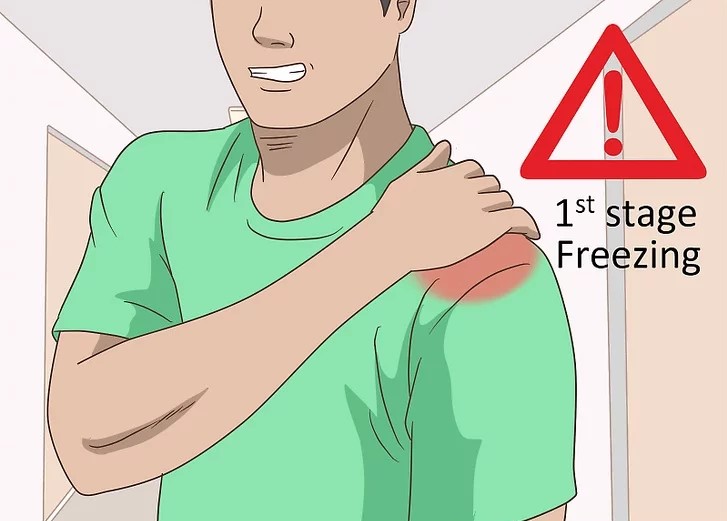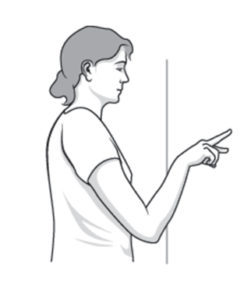What is Frozen Shoulder?
Frozen shoulder, also known as adhesive capsulitis, is a condition characterized by stiffness and pain in your shoulder joint which gradually gets worse. This can take anywhere from a year to 3 years.
Your shoulder is made up of three bones that form a ball-and-socket joint. They are your upper arm (humerus), shoulder blade (scapula), and collarbone (clavicle) and there’s also a tissue surrounding your shoulder joint that holds everything together, which is called the shoulder capsule. With frozen shoulder, the capsule becomes so thick and tight that it’s hard to move, which limits motion of your arm and shoulder.
Causes
Your risk of developing frozen shoulder increases if you’re recovering from a medical condition or procedure that prevents you from moving your arm — such as a stroke or a mastectomy.
The bones, ligaments and tendons that make up your shoulder joint are encased in a capsule of connective tissue. Frozen shoulder occurs when this capsule thickens and tightens around the shoulder joint, restricting its movement. Also, it’s more likely to occur in people who have diabetes or those who recently had to immobilize their shoulder for a long period, such as after surgery or an arm fracture.

Age and sex

Immobility or reduced mobility
People who’ve had prolonged immobility or reduced mobility of the shoulder are at higher risk of developing frozen shoulder. Immobility may be the result of many factors, including Rotator cuff injury, Broken arm, Stroke and Recovery from surgery.

Systemic diseases
Certain medical conditions can increase your risk too. You may also be more likely to get frozen shoulder if you have diabetes. About 10% to 20% of people with diabetes get frozen shoulder. Other medical problems like heart disease, thyroid disease, or Parkinson’s disease are linked to frozen shoulder, too.

Freezing stage:
Any movement of your shoulder causes pain, and your shoulder’s range of motion starts to become limited.
Frozen stage:
Pain may begin to diminish during this stage. However, your shoulder becomes stiffer, and using it becomes more difficult.


Frozen stage:
Pain may begin to diminish during this stage. However, your shoulder becomes stiffer, and using it becomes more difficult.

Thawing stage:
The range of motion in your shoulder begins to improve.
Diagnosis
Your shoulder is a complex joint that interacts with may structures, so shoulder pain can have multiple sources. Accurate diagnosis is key to effective treatment. During the physical exam, your doctor may ask you to move in certain ways to check for pain and evaluate your range of motion (active range of motion). Your doctor might then ask you to relax your muscles while he or she moves your arm (passive range of motion). Frozen shoulder affects both active and passive range of motion.
In some cases, your doctor might inject your shoulder with a numbing medicine (anesthetic) to determine your passive and active range of motion. Frozen shoulder can usually be diagnosed from signs and symptoms alone. But your doctor may suggest imaging tests — such as X-rays or an MRI — to rule out other problems.

Treatments
Over-the-counter nonsteroidal anti-inflammatory drugs (NSAIDs) like aspirin or ibuprofen can help relieve the pain and inflammation in your shoulder. If they don’t help, your doctor might prescribe a stronger medication. Also, treatment for frozen shoulder involves range-of-motion exercises in order to strengthen the arm and bring the motion back. We will talk about some of the recommended exercises in a later section too. Also, in some cases, if the initial treatment doesn’t bring relief to the patient, arthroscopic surgery may be indicated to loosen the joint capsule so that it can move more freely.
One of the most common causes of frozen shoulder is the immobility that may result during recovery from a shoulder injury, broken arm or a stroke. If you’ve had an injury that makes it difficult to move your shoulder, talk to your doctor about exercises you can do to maintain the range of motion in your shoulder joint. Dr Praveen Sarda recommends few exercises that may help patient with some quick relief in case of acute frozen shoulder pain and to strengthen their muscles for later prevention.

Towel stretch
Hold one end of a three-foot-long towel behind your back and grab the opposite end with your other hand. Hold the towel in a horizontal position. Use your good arm to pull the affected arm upward to stretch it. Do these 10 to 20 times a day.
Finger walk
Face a wall three-quarters of an arm’s length away. Reach out and touch the wall at waist level with the fingertips of the affected arm. With your elbow slightly bent, slowly walk your fingers up the wall, spider-like, until you’ve raised your arm as far as you comfortably can. Your fingers should be doing the work, not your shoulder muscles. Slowly lower the arm (with the help of the good arm, if necessary) and repeat. Perform this exercise 10 to 20 times a day.


Finger walk
Face a wall three-quarters of an arm’s length away. Reach out and touch the wall at waist level with the fingertips of the affected arm. With your elbow slightly bent, slowly walk your fingers up the wall, spider-like, until you’ve raised your arm as far as you comfortably can. Your fingers should be doing the work, not your shoulder muscles. Slowly lower the arm (with the help of the good arm, if necessary) and repeat. Perform this exercise 10 to 20 times a day.

Cross-body reach
Sit or stand. Use your good arm to lift your affected arm at the elbow, and bring it up and across your body, exerting gentle pressure to stretch the shoulder. Hold the stretch for 15 to 20 seconds. Do this 10 to 20 times per day.
Pendulum stretch
Do this exercise first. Relax your shoulders. Stand and lean over slightly, allowing the affected arm to hang down. Swing the arm in a small circle — about a foot in diameter. Perform 10 revolutions in each direction, once a day. As your symptoms improve, increase the diameter of your swing, but never force it.


Pendulum stretch
Do this exercise first. Relax your shoulders. Stand and lean over slightly, allowing the affected arm to hang down. Swing the arm in a small circle — about a foot in diameter. Perform 10 revolutions in each direction, once a day. As your symptoms improve, increase the diameter of your swing, but never force it.

